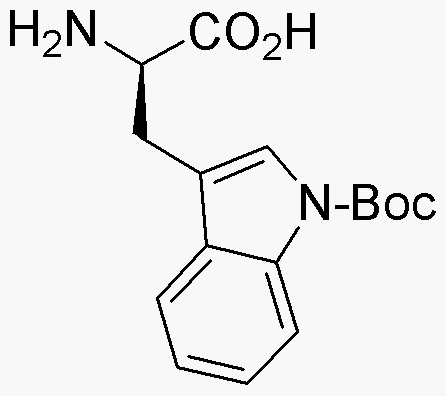Nin-Boc-D-tryptophan is widely utilized in research focused on:
- Peptide Synthesis: This compound serves as a key building block in the synthesis of peptides, particularly those that require the incorporation of tryptophan. Its protective Boc group allows for selective reactions, making it ideal for complex peptide sequences.
- Drug Development: In pharmaceutical research, it is used to develop novel compounds that can interact with serotonin receptors, which are crucial for treating mood disorders and other neurological conditions.
- Bioconjugation: The compound is employed in bioconjugation techniques, where it can be attached to various biomolecules. This application is essential in creating targeted drug delivery systems and diagnostic agents.
- Research in Neuroscience: Its role in serotonin metabolism makes it valuable in neuroscience studies, helping researchers understand the biochemical pathways related to mood regulation and depression.
- Protein Engineering: Nin-Boc-D-tryptophan is used in the engineering of proteins to enhance their stability and functionality, particularly in the development of enzymes and therapeutic proteins.
General Information
Properties
Safety and Regulations
Applications
Nin-Boc-D-tryptophan is widely utilized in research focused on:
- Peptide Synthesis: This compound serves as a key building block in the synthesis of peptides, particularly those that require the incorporation of tryptophan. Its protective Boc group allows for selective reactions, making it ideal for complex peptide sequences.
- Drug Development: In pharmaceutical research, it is used to develop novel compounds that can interact with serotonin receptors, which are crucial for treating mood disorders and other neurological conditions.
- Bioconjugation: The compound is employed in bioconjugation techniques, where it can be attached to various biomolecules. This application is essential in creating targeted drug delivery systems and diagnostic agents.
- Research in Neuroscience: Its role in serotonin metabolism makes it valuable in neuroscience studies, helping researchers understand the biochemical pathways related to mood regulation and depression.
- Protein Engineering: Nin-Boc-D-tryptophan is used in the engineering of proteins to enhance their stability and functionality, particularly in the development of enzymes and therapeutic proteins.
Documents
Safety Data Sheets (SDS)
The SDS provides comprehensive safety information on handling, storage, and disposal of the product.
Product Specification (PS)
The PS provides a comprehensive breakdown of the product’s properties, including chemical composition, physical state, purity, and storage requirements. It also details acceptable quality ranges and the product's intended applications.
Certificates of Analysis (COA)
Search for Certificates of Analysis (COA) by entering the products Lot Number. Lot and Batch Numbers can be found on a product’s label following the words ‘Lot’ or ‘Batch’.
*Catalog Number
*Lot Number
Certificates Of Origin (COO)
This COO confirms the country where the product was manufactured, and also details the materials and components used in it and whether it is derived from natural, synthetic, or other specific sources. This certificate may be required for customs, trade, and regulatory compliance.
*Catalog Number
*Lot Number
Safety Data Sheets (SDS)
The SDS provides comprehensive safety information on handling, storage, and disposal of the product.
DownloadProduct Specification (PS)
The PS provides a comprehensive breakdown of the product’s properties, including chemical composition, physical state, purity, and storage requirements. It also details acceptable quality ranges and the product's intended applications.
DownloadCertificates of Analysis (COA)
Search for Certificates of Analysis (COA) by entering the products Lot Number. Lot and Batch Numbers can be found on a product’s label following the words ‘Lot’ or ‘Batch’.
*Catalog Number
*Lot Number
Certificates Of Origin (COO)
This COO confirms the country where the product was manufactured, and also details the materials and components used in it and whether it is derived from natural, synthetic, or other specific sources. This certificate may be required for customs, trade, and regulatory compliance.


